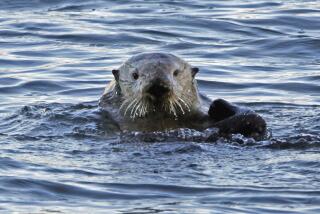Lionfish: If you can’t beat ‘em, eat ‘em
In recent years, the Indo-Pacific lionfish — a dramatically striped, finned and armored aquarium fish — has invaded Atlantic and Caribbean coral reefs. It has been spotted off the Southeastern United States, throughout the Caribbean Sea, in the Gulf of Mexico, and it’s now eating its way toward South America.
What’s to blame for this invasion? Most likely aquarium releases beginning in the early 1980s. And once introduced, lionfish took off. The fish has no known predator in the Atlantic. It reproduces rapidly and broadly: Females can lay eggs every four days. And lionfish have a huge and varied appetite. They eat more than 40 other types of fish, even other lionfish. And they thrive in a variety of environments.
And did I mention they were venomous? Their flamboyant spines contain neurotoxins that can be painful to other marine animals — and to humans, if you get stung.
Although the ecological effects of these fish are not yet fully understood, it’s clear they are upsetting food webs and competing for resources with native species. They are also adding stress to coral reefs and other marine ecosystems already under pressure from climate change. Warming sea temperatures, ocean acidification, increased pollution and overfishing all threaten reefs. If the spread of lionfish is not slowed, it may be the final straw.
It’s not as simple as eradication, though. The International Coral Reef Initiative, a global organization working to preserve coral reefs, created a committee to devise a battle plan. It concluded that eradication efforts would be doomed to failure because the fish has spread too far, too fast.
But there is another approach. Divers and environmentalists have a saying: “If you can’t beat ‘em, eat ‘em!”
Lionfish make for delicious, delicate, economical fillets that offer a perfect pop of protein. There are no catch limits, and they can be prepared dozens of ways. The Reef Environmental Education Foundation’s “Lionfish Cookbook” includes 45 recipes, from blackened fillets and nachos to “Spicy Lionfish with Dill Sauce.”
You do have to contend with the spines. If you’re a beginner, wear puncture-proof gloves and lop off the venomous spines with kitchen shears. (YouTube has the details.)
If we can create a market for lionfish as a food source, it could make an environmental difference. Small-scale efforts have made a dent in the population and distribution of lionfish in the past. But these efforts need to be sustained and expanded.
Some places are taking the initiative. In the Florida Keys, local organizations run lionfish derbies. Virgin Islands officials are making a case for locals to consume lionfish. But everyone can help. If you’re headed to the Atlantic or the Caribbean, you can dive, catch, cook and eat them yourselves. Or just request lionfish at your local restaurants or fish markets. It’s already on the menu at the Haven, in Houston, owned by Texan chef Randy Evans.
Lionfish as an invasive species has a negative effect on the coral reef ecosystem, but lionfish as a food commodity could be positive for local populations. If they become popular enough, lionfish have the potential to support a new fishery — increasing food security locally, putting money back into the economy and taking pressure off other overfished species.
The lionfish can be tamed. It’s one problem we may be able to solve simply by eating.
Chelsea Kahn is a graduate student at the University of Washington’s School of Marine and Environmental Affairs in Seattle. She is studying science communication.
More to Read
A cure for the common opinion
Get thought-provoking perspectives with our weekly newsletter.
You may occasionally receive promotional content from the Los Angeles Times.






